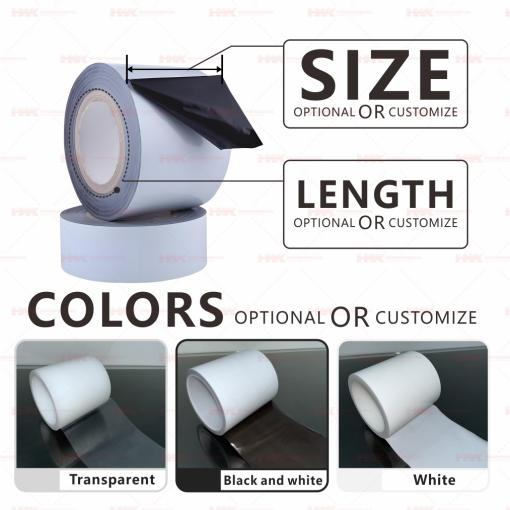אטבי פוליאתילן עם ציפורן נמצאו להם יישומים רבים בכל תחומי האיטום התעשייתי מאחר שהם גמישים, זולים ובעלי תכונות איטום חזקות. עם זאת, הגורם המכריע בשימושיות שלהם הוא משך האדהזיה. הכרה עם הגורמים שמשפיעים על היבט זה יכולה לתרום רבות לשיפור הביצועים והאמינות של אטבים אלה בסביבה תעשיונית. איכות הקשר וקיימותו הקצרה של אטבי פוליאתילן (PE) מושפעים בעיקר משתי תכונות – טכנולוגיית הקשיטה וה תנאים הסביבתיים, בעיקר בצורת רטיבות.
טכנולוגיית קשיטה בטפסים ציפורניים של פוליאתילן לאי קיימויות
הממצאה של טכנולוגיית הקשירה המצלבשת שינתה את הייצור והפעולה של סרטי סרף פוליאתילן. קשירה צלבית היא מנגנון שבו שרשראות הפולימר מופנו ליצירת רשת תלת ממדית שתגדיל את היציבות והעמידות של החומר. במקרה של סרטי PE, תהליך זה מעצים משמעותית את העוצמה המבנית ואת ההתנגדות למאמצים מכניים ול degradation סביבתי.

סרטי פוליאתילן קשורים צלבית נשארים יציבים גם בטמפרטורות גבוהות, גם בסביבות תעשייתיות שבהן תנודות טמפרטורה עשויות להיות בעייתיות. המבנה המולקולרי המקושר מונע מהסרט להנתך או להישבר תחת טמפרטורות גבוהות. תכונה זו אומרת שהשרף מצליח לשמור על עוצמה טובה של חיבור לאורך טווח רחב של תנאים קיצוניים, מה שמביא להרmetization תעשייתי איתן.
יתרה מכך, קשורת צולבת מספקת התנגדות כימית יוצאת דופן בפסי PE, כך שניתן להשתמש בחומר זה במיקומים שבהם ישנה בעיה של אי תאימות כימית. התנגדות זו תורמת גם למשך החיים של הפס באמצעות הגנה מפני האפקטים הרעים של כימיקלים שיכולים להחליש את הדבקות.
ניתן לומר שטכנולוגיית הקשורת הצולבת מאריכה את חיי הפסים הפוליאתילניים, וכן מרחיבה את תחומי היישום שלהם. פסי PE קשורים צולבת הם עמידים וברורים בפני אלמנטים קשים בתנאי תעשייה, ובכך מבטיחה את הדבקות לאורך תהליכי תעשייה מהירים.
גורמים סביבתיים: רטיבות והשפעת השפעתה על חוזק הדבקת הפסים
למרות שהצמתוק תורם רבות לעמידות של הסרט הפוליאתילן, תנאי הסביבה, ובפרט רמת הרטיבות עשויה להמשיך ולהשפיע על איכות הדבקת הסרט. רטיבות מתייחסת לרמת המים באטמוספירה וההשפעה של זה בולטת במיוחד על מוצרים דבקים.
כל הסרטים הדביקים, כגון אלה המיוצרים מפוליאתילן, הם די הידרופילים, כלומר יש להם את היכולת לספוג רטב. לטיפוסי PE יש נטייה להתנפח וכאשר תכונות הדבקה משתנות בסביבות עם לחות גבוהה, הם יכולים לאבד את אחיזתם. כאשר הסרט מתפרק כדי לספוג מים, שכבת הדבק יכולה לרכך, וזה עלול להפחית את יכולתה להגן על קשר קוהרנטי ככל שהזמן מתקדם.
שינויים בחומריות עשויים גם לגרום למחזורים של התרחבות/התכווצות בקלטת ובסובסטרטים עליהם היא מופעלת. מחזורים כאלה עלולים להוביל לדחוף את ממשק הדבקות, ועלולים להסתיים באובדן הדבקות אם הסרט חסר גמישות או התנגדות להתמודד עם תנועות אלה. לכן, חשוב לדעת מדוע תנאי הלחות הספציפית, שבהם יש להשתמש בקלטת PE, חייבים להיות מובנים כך שקלטת PE יכולה להישאר תקועה לאורך זמן.
כדי להתמודד עם ההשפעה של PA, חברות מציעות פתרונות של פסי PE בעלי תכונות של עמידות ברטיבות. חדשנות זו כוללת שינוי בתערובת של החומר הדבקי, כדי להגביר את עמידותו לספיח מים, וכך לשמור על חוזק הדבקה חזק גם בתנאי רטיבות מוגזמת. חשוב לבחור בפסים כאלו שישתמשו במתקדמים הללו ביישומים בהם רטיבות היא גורם מתמיד.
 EN
EN
 AR
AR
 CS
CS
 DA
DA
 NL
NL
 FI
FI
 FR
FR
 DE
DE
 EL
EL
 HI
HI
 IT
IT
 JA
JA
 KO
KO
 PL
PL
 PT
PT
 RO
RO
 RU
RU
 ES
ES
 TL
TL
 IW
IW
 ID
ID
 SR
SR
 UK
UK
 VI
VI
 HU
HU
 TH
TH
 TR
TR
 FA
FA
 AF
AF
 MS
MS
 GA
GA
 BE
BE
 IS
IS
 HY
HY
 BN
BN
 LA
LA
 MN
MN
 SO
SO
 MY
MY
 KK
KK

